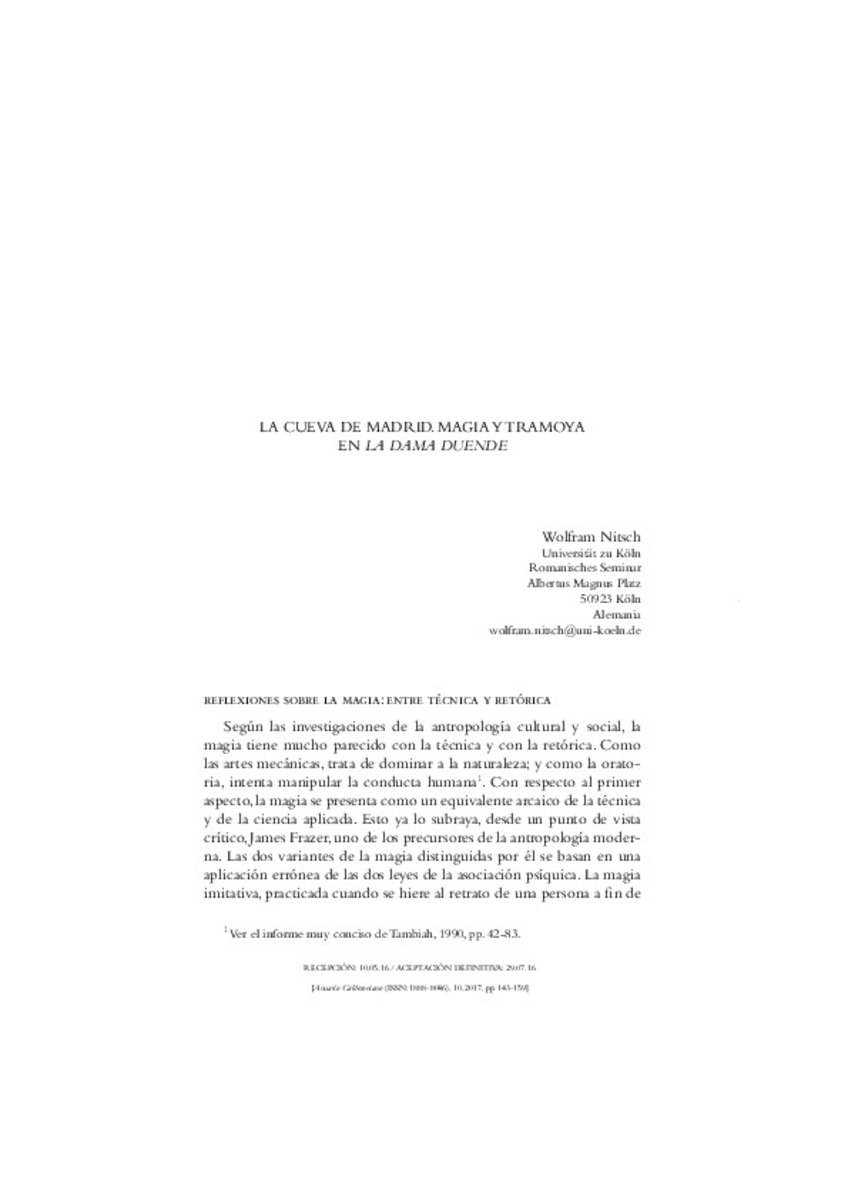Full metadata record
| DC Field | Value | Language |
|---|---|---|
| dc.creator | Nitsch W. (Wolfram) | - |
| dc.date.accessioned | 2019-07-02T08:01:39Z | - |
| dc.date.available | 2019-07-02T08:01:39Z | - |
| dc.date.issued | 2017 | - |
| dc.identifier.citation | Nitsch, Wolfram, «La cueva de Madrid. Magia y tramoya en “La dama duende”», Anuario Calderoniano, 10, 2017, pp. 143-159. | es_ES |
| dc.identifier.issn | 1888-8046 | - |
| dc.identifier.uri | https://hdl.handle.net/10171/57896 | - |
| dc.description.abstract | Si según las investigaciones de la antropología cultural la magia tiene mucho parecido tanto con la técnica como con la retórica, la magia artificiosa del teatro barroco resulta de una interacción sugestiva entre la escenotécnica y el arte de representar. La dama duende se puede leer como una puesta en escena original de esta interacción. Como la intriga de Doña Ángela de Toledo se basa no solamente en un juego de rol ingenioso, sino también en una invención técnica digna del «artificio de Juanelo», la comedia cómica más exitosa de Calderón junta dos vertientes de la magia del teatro que quedan separados en dos piezas contemporáneas inspiradas por la leyenda de la cueva mágica de Salamanca o de Toledo. Así, La dama duende traslada a Madrid, la capital del teatro aúreo, el famoso artificio de Toledo y la legendaria cueva de los encantadores —no sin demostrar la fuerza irresistible de este encanto sin encanto. | es_ES |
| dc.description.abstract | If, from an anthropological perspective, magical acts are similar to technical acts as well as to rhetorical acts, the artificial magic of baroque theatre results from a suggestive interaction between stage machinery and acting. La dama duende can be read as an original staging of this interaction. Since the intrigue of Doña Ángela de Toledo is based not only on an ingenious role-play, but also on a technical invention compared to the «artificio de Juanelo», Calderón’s best known comedy brings together two aspects of theatrical magic that appear separated one from another in two contemporary pieces inspired by the legend of the magical cave of Salamanca or of Toledo. Thus, La dama duende transfers to Madrid, the capital of Golden Age theatre, the famous artifice of Toledo and the legendary hiding-place of magicians —not without demonstrating the irresistible spell of stage magic. | es_ES |
| dc.language.iso | spa | es_ES |
| dc.publisher | Iberoamericana/Vervuert | es_ES |
| dc.rights | info:eu-repo/semantics/openAccess | es_ES |
| dc.subject | Materias Investigacion::Filología y Literatura | es_ES |
| dc.subject | Calderón de la Barca | es_ES |
| dc.subject | La dama duende | es_ES |
| dc.subject | Magia artificiosa | es_ES |
| dc.subject | Escenotécnica | es_ES |
| dc.subject | Simulación teatral | es_ES |
| dc.subject | Artificial magic | es_ES |
| dc.subject | Stage machinery | es_ES |
| dc.subject | Role-play | es_ES |
| dc.title | La cueva de Madrid. Magia y tramoya en “La dama duende” | es_ES |
| dc.type | info:eu-repo/semantics/article | es_ES |
| dadun.citation.endingPage | 159 | es_ES |
| dadun.citation.startingPage | 143 | es_ES |
| dadun.citation.volume | 10 | es_ES |
Files in This Item:
Statistics and impact
Items in Dadun are protected by copyright, with all rights reserved, unless otherwise indicated.






